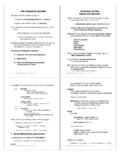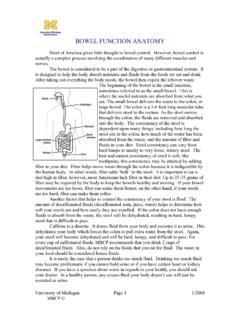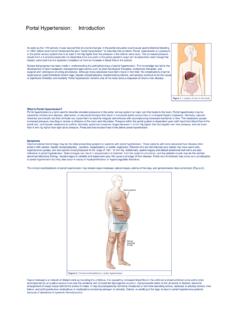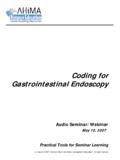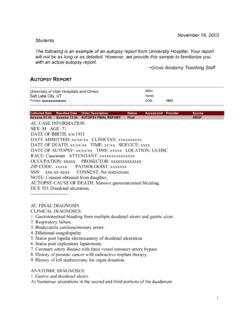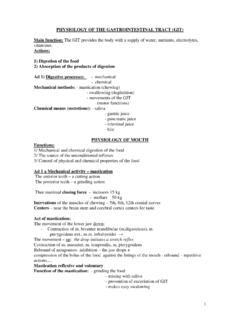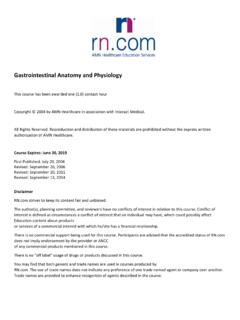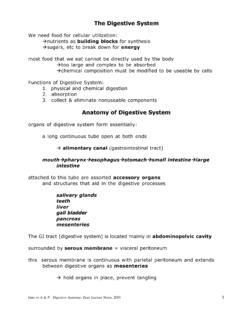Transcription of Introduction to Anatomy, Chapter 1 - Dr. Scott Croes' Website
1 1 Introduction to anatomy , Chapter 1 Outline of class notes Objectives: After studying this Chapter you should be able to: 1. Define anatomy and physiology. 2. Explain why anatomy today is considered a relatively broad science and discuss its various disciplines. 3. List and describe the 6 levels of structural organization. 4. Name and give examples of the four tissue types of the body. 5. List the 11 principal systems of the body, their functions, and representative organs. 6. Describe anatomical position and the four major body reference planes 7. Describe the major body cavities and their representative organs. 8. Be able to use anatomical vocabulary utilizing directional terms, regional names and quadrants.
2 9. Describe (compare and contrast) the following common medical imaging procedures: Conventional Radiography (x-rays), Magnetic Resonance Imaging (MRI), Computed Tomography (CT), Ultrasound, Positron Emission Tomography (PET), and Digital Subtraction Angiography (DSA). Chapter Overview Divisions of anatomy Structural and functional organization of the body Levels of organization Organ systems Properties of life Anatomical terminology Directional terms Body planes and sections Body cavities Abdominal regions and quadrants Medical Imaging Techniques anatomy Defined anatomy is the study of structure and the relationships among structures.
3 Structure refers to the shapes, sizes, and characteristics of the components of the human body. anatomy is a Greek term that originates from 2 words: Ana which means up or apart Tomos which means to cut Physiology Defined Physiology is the study of how the body parts function Explains the how and why Physiology is where we figure out how stuff works. How do muscles contract? How are neural impulses formed? How do RBCs carry oxygen? 2 Disciplines of anatomy anatomy is a relatively broad science because it can be divided into various disciplines. Gross anatomy (macroscopic): Study of stuff seen by the naked eye. Microscopic anatomy : Study of stuff seen ONLY with the microscope.
4 Includes: Histology Study of tissues Cytology Study of individual cells and their internal structures Surface anatomy : Study of superficial markings. Pathological anatomy : Study of structural changes associated with disease. Regional anatomy : Study of the body by areas (head, trunk). Systemic anatomy : Study of the body by systems (renal, digestive) Developmental anatomy : Study of development from fertilized egg through adult. Embryology: Study of development from fertilized egg through the eighth week of utero. Radiographic anatomy : Use of imaging techniques (x-ray, ultrasound, MRI) Levels of Structural Organization Levels of Structural Organization The human body consists of several levels of structural organization, which interact to perform specific functions.
5 1. Chemical level: Atoms and molecules Atoms: Made of subatomic particles: protons, neutrons and electrons. C, H, O, N, Ca, P make up 99% of our body weight Molecules: Two or more atoms held together by covalent bonds. Ex: water, DNA, proteins, carbohydrates, vitamins. Molecules are organized into organelles. Percentage of elements that make up the human body 3 2. Cellular Level Organelles: Functional components of cells. Ex: nucleus, mitochondria Cells: Fundamental functional unit of life. Cell theory 2 parts All organisms are made of cells Schleiden and Schwann (1839) All cells come from pre-existing cells Virchow (1839) 3.
6 Tissue Level Tissues: Groups of similar cells and their extracellular matrix joined together to perform the same general function. Four types of tissues: Muscle, epithelial, connective, nervous Tissue Level (cont) Three embryonic tissues give rise to the 4 primary adult tissues and various organs. 1. Endoderm: Endocrine glands, epithelium of the gastrointestinal tract, lungs, and many organs. 2. Mesoderm: Blood, muscle, bone, and connective tissue. 3. Ectoderm: All nervous tissue and the epithelium of the skin the epidermis. 4 4. Organ Level Organs: Combination of two or more different tissues that have specific functions Ex: stomach, heart, lungs, brain 5.
7 Organ System Organ system: Two or more organs which function together for a common purpose Ex: Digestive system includes the liver, stomach, intestines, pancreas, and salivary glands. 6. Organism: All the body systems functioning together Test Your Knowledge? 1. The smallest living units in the body are: A. Elements C. Cells B. Subatomic particles D. Molecules 2. The level of organization that reflects the interactions between organ systems is the: A. Cellular Level C. Molecular Level B. Tissue Level D. Organism Overview of the 11 Organ Systems Integumentary System Structures: Skin, hair, nails, sweat and oil glands Functions: Provides a protective barrier for the body Aids in vitamin D production Helps in waste elimination Prevents desiccation, heat loss, and pathogen entry Contains sensory receptors for pain, touch, and temperature Skeletal System Structures: Bones (206 total) and associated joints, cartilages, and ligaments Functions.
8 Protects and supports body organs Provides a framework that muscles can use to create movement Hemopoiesis (synthesis of blood cells) Mineral storage Bone contains 99% of the body s store of what mineral? (Hint you can get this mineral from drinking milk) Muscular System Structures: The 600+ skeletal muscles of the body Attached to skeleton by tendons Functions: Body movements Maintains posture Thermogenesis (generation of heat) 5 Nervous System Structures: Brain, spinal cord, peripheral nerves, and sense organs Functions: Fast-acting control system of the body Controls cell function with electrical signals called action potentials.
9 Monitoring of the internal and external environment and responding (when necessary) by initiating muscular or glandular activity Endocrine System Structures: Discrete hormone producing glands: Pituitary, Thyroid, Parathyroid, Pineal, and Adrenal glands. Hormone producing cells within other organs and tissues: Hypothalamus, Pancreas, Small Intestine, Stomach, Testes, Ovaries, Kidneys, Heart, Placenta and Thymus Functions: Regulates body activities through hormones Long-term control system of the body (slow acting) Regulates growth, metabolism reproduction, and many other processes. Cardiovascular System Structures: Heart, Blood vessels, and blood Functions: Transports nutrients (glucose, amino acids, lipids), gases (O2, CO2), wastes (urea, creatinine), and hormones.
10 Helps regulate body temperature and protect against disease Lymphatic System Structures: Lymph, Lymphatic vessels, and organs containing lymphatic tissue such as lymph nodes, spleen, thymus, red bone marrow Functions: Returning leaked fluid back to the bloodstream Transports fats from GI tract Filters (removes) foreign substances from blood and lymph Combats disease (pathogens) Respiratory System Structures: Lungs and associated passageways (Nasal cavity, pharynx, trachea, bronchi) Functions: Supplies O2 and eliminates CO2 Regulates blood pH Produces vocal sounds 6 Digestive System Structures: gastrointestinal tract (oral cavity, pharynx, esophagus, stomach, small intestine, large intestine, rectum, anus) and associated organs (teeth, salivary glands, pancreas, liver, gallbladder) Functions: Breaks down food into units that can be absorbed by the body by: Mechanical processes Chemical processes Urinary System Structures: Kidneys, ureters, urinary bladder, urethra Functions: Removal of nitrogenous wastes (urea, uric acid, and ammonia) from protein and nucleic acid metabolism Maintains the body fluid volume, pH, and electrolyte levels.


